Have you ever stumbled upon forgotten cannabis you found tucked away in a closet or drawer and questioned whether or not it’s still safe to smoke? We’re here to provide answers. In this article, we’ll unravel the mysteries of weed expiration, equipping you to make informed decisions about your stash. We’ll delve into the science of weed degradation and help you recognize the signs of ageing buds so you can make the most informed decisions about what you put into your body.
Understanding weed expiration isn’t mere curiosity; it’s about ensuring you get the best possible experience from your weed. As time passes, cannabis undergoes changes that influence its effects, flavour, and overall quality. From the makeup of cannabis, including cannabinoids and terpenes, to the factors contributing to weed degradation, we’ll cover it all. You’ll also gain insights into proper storage techniques to maintain your cannabis’s freshness and discuss potential health risks associated with old weed–and how to evaluate older cannabis products. Whether you’re an experienced weed lover or just getting started, we’re breaking down everything you need to know below.
Does Weed Go Bad?
Alright, we’ve established the need to dive into weed expiration. But before we go any further, let’s address the big question: does weed actually go bad? The answer might not be as straightforward as you’d think, but we’re here to clear the haze.
First things first, let’s dissect what makes up weed. Cannabis is a plant, and we smoke the flowers after they’ve been cured, which keeps them stable on the shelf for a long time as long as it’s stored properly. But more than drawing out moisture and preserving buds naturally, cannabis is more than its structure. It’s made up of a bunch of different compounds that work together to get you high and provide other effects. And it’s also full of compounds that make your weed smell and taste good.
This complex mix of compounds works in harmony. We’ve got cannabinoids, the chemical wizards responsible for the effects you feel, and terpenes, the aromatic molecules that bring those delightful flavours and scents. These two are your weed’s dynamic duo, which work together to promote effects. We’ll dive further into that in a minute.
But back to the main point: why does freshness matter if weed itself is shelf stable in the long term? Freshness is not just about bragging rights; it’s about the quality of your high. As cannabis ages, the balance of cannabinoids and terpenes can shift, altering both the potency and the flavours you savour. So, yes, freshness is vital to an optimal experience.
The twist is that weed doesn’t exactly expire in the way your milk might curdle. Instead, it degrades, and the degradation rate depends on various factors. So, while it usually won’t go ‘bad’ like spoiled food, it can undoubtedly deteriorate to a point where it’s no longer worth indulging in.
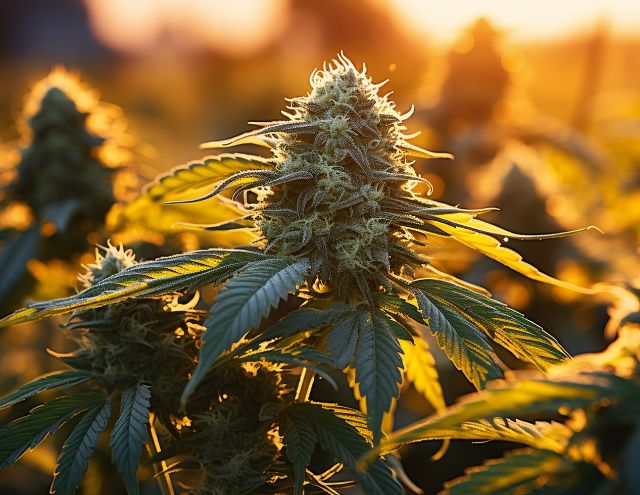
The Science Behind Weed Degradation
As we mentioned, weed doesn’t really expire to the point that it’ll make you sick, but it does break down. As it breaks down, it becomes less potent and flavourless, turning it into something that isn’t worth smoking. On the other hand, the plant materials can break down if stored improperly. While the curing process makes weed shelf stable, high moisture levels and exposure to environmental contaminants can cause it to rot or grow mould, which makes it unsafe to smoke. We’ll touch more on that later.
For now, potency takes centre stage. Several factors contribute to how quickly your weed breaks down, so welcome to the science class you never had in school. Here’s what’s happening to your weed as it ages:
Cannabinoids
Cannabinoids are the backbone of your cannabis experience, the compounds that bring euphoria, relaxation, and therapeutic benefits. These compounds work with our endocannabinoid system to produce the effects you’d expect from weed and include the ones you’re familiar with, like THC and CBD. However, there are over 100 different cannabinoids in cannabis, and each one plays a role.
Enter the entourage effect. The entourage effect is a scientific phenomenon highlighting how cannabinoids may feel more potent when they’re together. THC is great on its own, but when you smoke it with the other natural cannabinoids found in weed, like CBG or CBN, evidence suggests that the effects THC produces are stronger. That said, the more cannabinoids, the merrier! It’s imperative to preserve as many cannabinoids as possible for the most potent experience you can have with weed.
What factors degrade cannabinoids?
However, cannabinoids aren’t invincible, and their stability depends on several external factors:
1. Oxygen Exposure: When your weed is exposed to oxygen, it can kickstart chemical reactions that break down those precious compounds. It can cause excess dryness, which evaporates a lot of your more minor cannabinoids out, which hurts the entourage effect. While THC doesn’t seem to evaporate away like other cannabinoids and terpenes, evidence suggests that oxygen can trigger the chemical reaction that transforms the potent THC into the less effective and sedative cannabinoid CBN–which is believed to be the cannabinoid responsible for making you feel couch-locked.
2. Temperature Fluctuations: Just as you prefer a steady climate, so do cannabinoids. Extreme temperature swings can hasten their degradation, whether too hot or too cold. High temperatures transform THC by activating it before you’re ready to smoke it, which will leave you with a largely ineffective smoke sesh. On the other hand, weed stored too cold is prone to breaking. Cannabinoids are stored in the trichomes of your flowers, and they’re more likely to fall off with freezing temperatures or rough handling.
3. Light Exposure: Cannabis plants might enjoy soaking up the sun, but your delicate flowers and cannabinoids? Not so much. UV rays and even prolonged exposure to artificial light can lead to cannabinoid degradation, robbing your stash of its potency. These rays break down the organic plant matter but also trigger THC to transform into CBN. That’s why storing your stash in the dark is so important.
4. Moisture Content: While buds are pretty shelf stable after the drying and curing process, it’s essential to keep them at a balanced humidity level that prevents mould growth, making your stash completely unusable and unsafe to smoke. However, humidity also can’t be too low. In low humidity, cannabinoids and terpenes evaporate, leaving you with buds that smell like hay, taste bad, and don’t feel as potent.
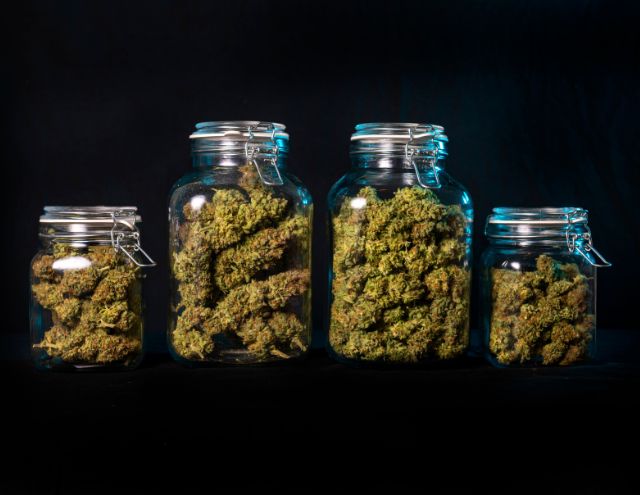
How cannabinoid degradation affects your high
Every cannabinoid has a half-life–the time it takes for half of its original level to degrade without considering external factors, such as oxygen and light exposure. Science is still determining what the half-life of THC is since it’s so sensitive to its environment, but like all things, it naturally decays even if you’re doing everything right in terms of storage. Even perfectly preserved weed might feel less potent after a year than it did when it was first put into storage. However, the environmental factors mentioned above can accelerate this process. That means if you’re not storing your cannabis right, those cannabinoids can diminish faster than you’d like.
The big question: how does all this affect your high? The degradation of cannabinoids directly impacts potency. As they break down, the concentration of active compounds decreases, resulting in a milder experience. With fewer cannabinoids to create an entourage effect and a lower starting potency, that once-powerful strain might leave you feeling less enchanted if not stored properly.
Terpenes
Cannabinoids are only part of the story when it comes to the science of weed degradation. As we mentioned, cannabinoids and terpenes work together to promote an entourage effect, which helps balance out your high.
Terpenes are molecules responsible for the scents and flavours of your favourite strains. However, they also come with their own potential benefits and play a role in shaping your entire experience. Terpenes are arguably just as crucial to your high as cannabinoids. Sure, you can still get high from weed that tastes like hay. But when it tastes fresh and more like weed, terpenes and cannabinoids are hard at work producing effects.
How? Terpenes are believed to play more of a role in how a strain feels than genetics. For that reason, the indica, sativa, and hybrid models are antiquated ideas that cover more of what a strain feels like versus what it identifies as on a genetic level.
Strains higher in sedative or relaxing terpenes like b-caryophyllene or linalool are often labelled as Indicas. In contrast, strains high in pinene, myrcene, and limonene tend to feel more like a Sativa. These fragrant compounds aren’t just responsible for the delightful scents and flavours in your cannabis; they help shape how a strain will affect you.
What factors degrade terpenes?
Terpenes, like cannabinoids, are also quite delicate. The key to preserving terpenes is proper humidity and containers that prevent evaporation over time.
Terpenes are considered to be highly volatile, so they have a very short half-life, even under perfect conditions. As time passes, they break down or disappear altogether, which considerably reduces the flavours and effects you’d expect from your weed.
They can also evaporate over time, especially if you’re not storing your cannabis correctly. Like cannabinoids, terpenes are sensitive to heat, light, and oxygen. Oxygen exposure causes a lot of terpenes to evaporate out. Extremely high temperatures also contribute to evaporation but can also cause terpenes to reach the point that they boil out of your buds. While light won’t cause terpenes to transform into other compounds, it does contribute to evaporation.
Those terpenes start evaporating shortly after the plant is cut down. While many of them evaporate during the drying process, there’s still a surplus in cured weed–which is why proper storage is so crucial for preserving them and getting the most out of your weed in terms of flavour and potency.
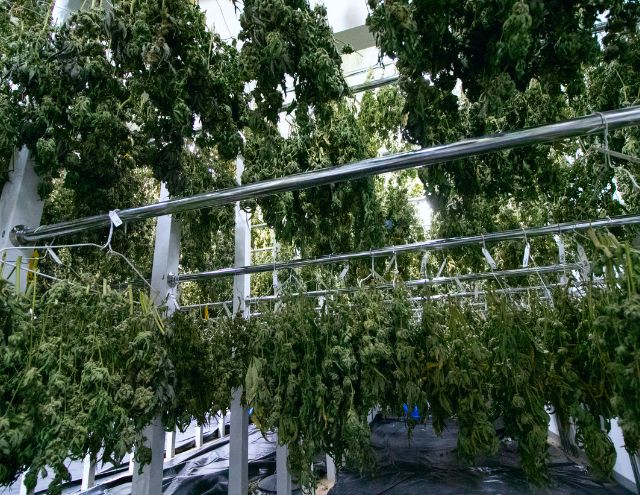
How terpene degradation affects your high
Just like cannabinoids benefit from the presence of other cannabinoids, they also benefit from the presence of terpenes. The more terpenes you preserve, the more potent your weed will feel. All that is to say that the loss of terpenes can impact your high beyond just the taste and smell. Your high depends on keeping those terpenes under the perfect conditions.
As terpenes degrade, you’re not just losing out on a pleasant scent and flavour – you’re also potentially diminishing the nuanced effects of your cannabis. That’s why understanding how terpenes interact with cannabinoids and their role in the entourage effect is crucial for appreciating the full spectrum of your weed’s potential.
The Hidden Dangers of Improper Storage
Sure, proper storage is crucial if you want to prevent cannabinoids and terpenes from degrading and affecting your potency. But improper storage isn’t just about less-than-stellar experiences; it can pose actual health risks.
Weed doesn’t typically expire in the traditional sense, but it can become less potent and less enjoyable to smoke over time. However, the real concern lies in the potential dangers of improperly stored cannabis. Exposing your weed to dust, dirt, or high moisture levels can lead to mould and contaminants from the environment making their way into your stash. Smoking contaminated or mouldy weed can indeed make you sick.
So, remember, the way you store your weed isn’t just about flavour – it’s about safety too.
Signs of Weed That’s Past Its Prime
How do you know if your weed isn’t worth smoking anymore or if it’ll make you sick? The key is in your senses. Here are a few things you can observe to determine whether or not that nug of weed you found behind the toolbox in the garage is worth smoking.
Visual Indicators
- Visual Contaminants: If the bud you found wasn’t in a storage container and you just found it a few days later under the couch after dropping it, it might still be okay to smoke as long as it wasn’t exposed to anything that can make you sick. Be on the lookout for dust, dirt, and debris–like pet hair. Nothing other than clean air should ever go into your lungs, so avoid smoking buds that look physically dirty.
- Mould or Mildew: The presence of mould or mildew is a major red flag, and you should never smoke mouldy weed, no matter how desperate you are. If you spot any fuzzy white or green patches on your buds, it’s time to say goodbye. Smoking mouldy cannabis can be harmful to your health.
- Trichome Alterations: Trichomes are those tiny, glistening crystals on your buds. They’re packed with cannabinoids and terpenes. If you use a magnifying glass and notice that trichomes have turned mostly brown or amber instead of a 50/50 split between amber and cloudy, it could mean that your cannabis has degraded and lost some of its potency.
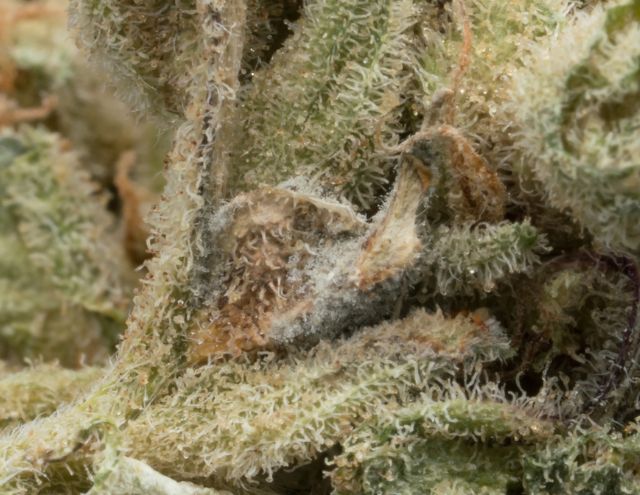
Aroma and Flavour Indicators
- Off-Putting Odour: A healthy batch of cannabis should have a distinct and pleasant aroma. If your weed smells musty, like hay, or has an off-putting odour, it’s a sign that something’s amiss and may be mouldy or unsafe to smoke altogether. Trust your nose; it often knows best.
- Loss of Aroma: On the other hand, if your weed looks fine and doesn’t smell bad but takes on a lack of aroma, it may still be safe to smoke. Sure, many of the terpenes and cannabinoids have likely evaporated, and it won’t be a very good smoke, but it won’t make you sick.
- Changes in Flavour: Pay attention to the taste when you light up. If your cannabis lacks the characteristic flavours you’re used to or has a bland, harsh taste, it may have deteriorated. It’s usually okay to smoke at this point, but it won’t feel as great as it usually does.
Touch Indicators
- Mushiness: If your cannabis feels overly soft, almost mushy when you touch it, it’s a clear indication that moisture has taken a toll. This can affect its burn and overall quality, but there may also be mould spores lurking inside that you don’t want to inhale.
- Overly Dry Buds: On the flip side, if your weed is bone-dry and crumbles easily, it has likely lost its moisture content. Extremely dry cannabis can be harsh on the throat and less enjoyable to smoke. It’s often less potent and flavourful, but it’s generally safe to smoke if it hasn’t been contaminated by dust or other debris.
- Difficulty Rolling or Packing: If your weed has become extremely brittle or sticky, it can be a sign that it is past its prime. Difficulty rolling or packing can be a practical sign that your cannabis has dried out excessively and turned harsh and flavourless or been exposed to too much moisture–which is a red flag for mould that renders it unsafe to smoke.
Remember, the goal is to enjoy weed that tastes and feels great. While cannabis doesn’t typically “expire” like perishable food (unless, of course, it’s exposed to contaminants or mould), it can certainly lose its appeal. Keeping an eye out for these signs can help you make an informed decision about whether it’s time to retire your stash and hit the dispensary for some fresh bud.
Storage Tips for Prolonging Weed Freshness
While weed degrades naturally, proper storage is everything to prolong the degradation process and keep your weed in its prime longer. We wrote an in-depth article on the best practices for storing cannabis flowers and other products that we recommend checking out for a more in-depth look at storage tips, but the gist is this:
- Store your buds in an airtight container that keeps humidity in and oxygen out–like a mason jar.
- Keep your airtight container away from sunlight and artificial light sources in a dark closet or drawer.
- The area you choose to store your buds should be cool and dry. Aim for a place within your home at 15-20°C (60-68°F).
- Your buds should be kept in a container at a Relative Humidity between 55-62%. You can use 2-way humidity packs to keep it in the perfect range and monitor your stash using a hygrometer.
- Avoid shaking the jar or jostling your buds often, as frequent handling can break trichomes off of the buds, harming your potency. It helps to handle weed with gloves or tongs to help preserve their structure and minimise introducing contaminants into your storage container.
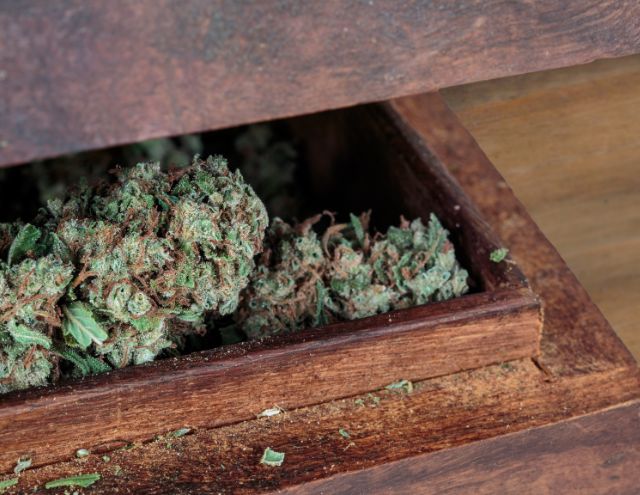
Can Expired Weed Make You Sick?
As cannabinoids and terpenes degrade over time, your high may become milder and less enjoyable. However, cannabis with multiple indicators of mould or contaminants can make you sick. If your weed shows signs of mould, mildew, excessive moisture, or contamination, it’s best to steer clear. Smoking mouldy or contaminated cannabis can indeed pose health risks.
Mould, in particular, can be harmful when inhaled. It can lead to respiratory problems and allergic reactions. Contaminants from the environment, such as dust or dirt, can introduce toxic substances into your cannabis and, ultimately, your lungs, which is never a good idea and can lead to long-term health problems.
So, is it safe to consume expired weed? Generally, if it shows no signs of mould or contaminants, it should be safe–just less potent. However, it’s crucial to be cautious and use your judgment. When in doubt, err on the side of caution and throw it away. Weed is cheaper than ever, and a trip to the dispensary for fresh weed can save you a lot of stress.
Ultimately, the key takeaway is that you should throw it out if you’re in doubt. When weed expires, it loses potency but is still generally safe to smoke. On the other hand, when it goes bad (i.e., growing mould, feeling mushy, or smelling bad), it’s not safe to smoke and can make you sick.
Conclusion
Understanding the nuances of weed degradation and preservation can elevate your experience from ordinary to extraordinary. Preservation matters, and it starts with proper storage and awareness of the factors that affect cannabis degradation–potency, flavour, and aroma depend on it.
Recognizing visual cues, aroma and flavour changes, and trichome alterations becomes your first line of defence against consuming cannabis past its prime. Safety is paramount, too; while expired weed may not make you sick in the traditional sense, the potential presence of mould and contaminants should be taken seriously. Trust your senses and err on the side of caution.
Remember, cannabis doesn’t have a set expiration date, but it does have a peak period. When in doubt, when it looks, smells, or tastes off, it’s time to re-up. Life’s too short to smoke lousy weed–so when in doubt, always throw it out!
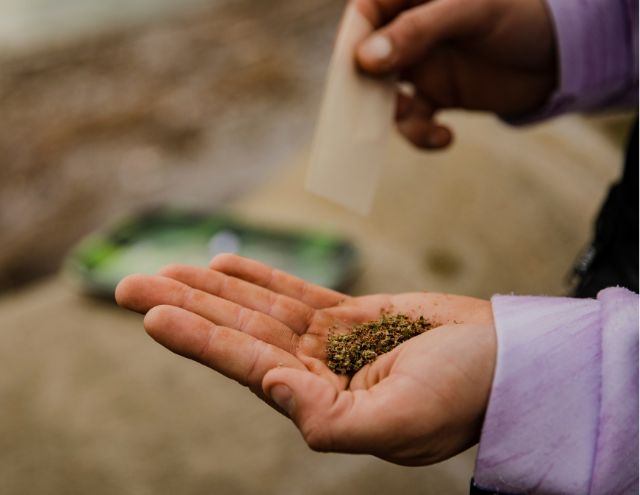
FAQs
1. Does weed actually expire?
Yes and no. While weed doesn’t have a strict expiration date like food products, it degrades over time, which can affect its potency, flavour, aroma, and overall effects. In most cases, it’s still safe to smoke when it’s past its prime and proper storage can help prolong its quality. On the other hand, it can be dangerous to smoke if your weed looks, smells, tastes, or feels weird. Always be on the lookout for mould, which is the number one sign of expired weed that needs to be thrown out.
2. How can I tell if my weed has gone bad?
You can assess your weed’s condition by looking for visual indicators like mould, mildew, or mushiness. Pay attention to changes in aroma, appearance, and flavour; when in doubt, be sure to throw it out.
3. Is it safe to consume expired weed?
Generally, if it has been stored correctly and shows no signs of mould or contaminants, it should be safe, albeit less potent. However, it’s essential to use your judgment and trust your senses. It’s not safe to consume mouldy or contaminated weed, so when in doubt, opt for fresh cannabis.
4. Can I do anything to prevent or slow down the degradation of my weed?
Absolutely. Proper storage is vital to slowing down degradation. Use airtight containers, maintain ideal temperature and humidity levels, and avoid exposure to light and oxygen.
5. Are there any ways to revive or enhance the quality of older weed?
Reviving old weed isn’t easy. While some methods, like rehydrating overly dry buds, may help a bit, they won’t restore lost potency or terpenes. It’s often best to enjoy your cannabis while it’s at its freshest.






Leave a Reply